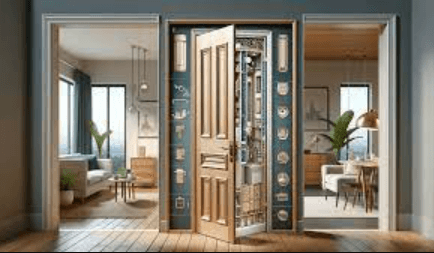Elevating Entryways: The Art of Architrave Doors in Interior Design

In the realm of interior design, doors serve as more than mere entry points; they are opportunities to make a statement and add a touch of architectural elegance to a space. Enter the architrave door, a design element that transcends functionality, bringing a sense of refinement and sophistication to entryways. In this exploration, we unravel the artistry of architrave door, delving into their historical roots, diverse styles, and the transformative impact they have on interior aesthetics.
Historical Roots and Evolution:
The term architrave finds its origins in classical architecture, referring to the horizontal beam resting atop columns. In the context of doors, the architrave serves as the decorative molding or trim surrounding the door frame. Historically, architrave doors were prevalent in neoclassical and classical architectural styles, reflecting an era where intricate detailing and grandeur were highly valued. Over time, this design feature has evolved, finding its way into various design styles while retaining its timeless allure.
Architectural Accentuation:
Architrave doors act as architectural accentuations that frame and highlight the entryway. The molding that surrounds the door adds a layer of visual interest, transforming an ordinary door into a focal point. The architrave serves as a transition between the door and the surrounding wall, creating a sense of balance and proportion that enhances the overall architectural aesthetics of a space.
Diverse Styles for Every Design Palette:
One of the remarkable aspects of architrave doors is their versatility. They come in a diverse range of styles, adapting to different design palettes and architectural themes. From ornate and traditional architraves with intricate detailing to sleek and modern profiles that embrace simplicity, architrave doors can be customized to suit various interior design preferences. This adaptability makes them a valuable asset in both classic and contemporary settings.
Framing Focal Points:
Doors, being functional elements, often serve as focal points within a room. Architrave doors take this a step further by framing and accentuating the importance of the doorway. The carefully chosen molding around the door not only draws attention to its architectural significance but also creates a visual frame that adds a layer of depth and sophistication to the overall design.
Material Choices and Finishes:
Architrave doors come in a variety of materials, each offering a unique character to the overall design. Wood, known for its warmth and versatility, is a popular choice, allowing for intricate detailing and customization. Other materials, such as MDF or polyurethane, offer a smooth and consistent surface, ideal for achieving a contemporary and uniform look. The choice of finishes, whether it’s painting, staining, or leaving the material in its natural state, further contributes to the customization possibilities of architrave doors.
Functional Elegance:
Beyond their aesthetic appeal, architrave doors serve a practical purpose. The molding around the door helps conceal the joint between the door frame and the wall, creating a seamless and finished appearance. This not only enhances the visual appeal of the door but also showcases attention to detail in the design process. The combination of functional and aesthetic elements elevates architrave doors to a status of functional elegance.
Read also: The Evolution of NYC DJ Culture: A Retrospective Look at Its Roots
Continuity in Design:
Architrave doors contribute to the continuity of design throughout a space. When chosen thoughtfully, they can serve as a unifying element that ties together various architectural features and design elements within a room. This cohesiveness enhances the overall flow and harmony of the interior, creating a more visually appealing and inviting atmosphere.
Conclusion:
In the grand tapestry of interior design, architrave doors emerge as integral threads that weave together elegance and functionality. From their historical roots in classical architecture to their diverse styles that cater to modern design sensibilities, architrave doors stand as a testament to the enduring allure of thoughtful detailing. As designers and homeowners seek to make a lasting impression within their living spaces, the art of architrave doors continues to leave an indelible mark, transforming doorways into statements of refined design and timeless sophistication.





